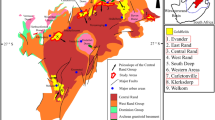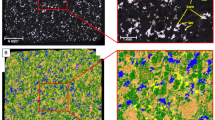Abstract
Heavy rare earth elements (HREEs) such as Gd–Lu, Sc and Y are irreplaceable metals for a number of critical (including clean) technologies, but they are scarce. Ion-adsorption deposits, which form within weathering crusts, supply more than 95% of the global HREE demand. However, these deposits are currently mined via ammonium-salt-based leaching techniques that are responsible for severe environmental damage and show low recovery efficiency. As a result, the adoption of such techniques is restricted for REE mining, further exacerbating REE scarcity, which in turn could lead to supply chain disruptions. Here we report the design of an innovative REE mining technique, electrokinetic mining (EKM), which enables green, efficient and selective recovery of REEs from weathering crusts. Its feasibility is demonstrated via bench-scale, scaled-up and on-site field experiments. Compared with conventional techniques, EKM achieves ~2.6 times higher recovery efficiency, an ~80% decrease in leaching agent usage and a ~70% reduction in metallic impurities in the obtained REEs. As an additional benefit, the results point to an autonomous purification mechanism for REE enrichment, wherein the separation process is based on the mobility and reactivity diversity between REEs and metallic impurities. Overall, the evidence presented suggests that EKM is a viable mining technique, revealing new paths for the sustainable harvesting of natural resources.
This is a preview of subscription content, access via your institution
Access options
Access Nature and 54 other Nature Portfolio journals
Get Nature+, our best-value online-access subscription
$29.99 / 30 days
cancel any time
Subscribe to this journal
Receive 12 digital issues and online access to articles
$119.00 per year
only $9.92 per issue
Buy this article
- Purchase on Springer Link
- Instant access to full article PDF
Prices may be subject to local taxes which are calculated during checkout





Similar content being viewed by others
Data availability
All data generated for this study are available in the paper and the Supplementary Information.
References
Cockell, C. S. et al. Space station biomining experiment demonstrates rare earth element extraction in microgravity and Mars gravity. Nat. Commun. 11, 5523 (2020).
Li, L. et al. General synthesis of 2D rare-earth oxide single crystals with tailorable facets. Natl Sci. Rev. 9, nwab153 (2021).
Lee, J. C. K. & Wen, Z. Pathways for greening the supply of rare earth elements in China. Nat. Sustain. 1, 598–605 (2018).
Xu, C. et al. Origin of heavy rare earth mineralization in South China. Nat. Commun. 8, 14598 (2017).
Li, M. Y. H., Zhou, M.-F. & Williams-Jones, A. E. The genesis of regolith-hosted heavy rare earth element deposits: insights from the world-class Zudong deposit in Jiangxi province, South China. Econ. Geol. 114, 541–568 (2019).
Stone, R. As China’s rare earth R&D becomes ever more rarefied, others tremble. Science 325, 1336–1337 (2009).
Zhou, F. et al. Selective leaching of rare earth elements from ion-adsorption rare earth tailings: a synergy between CeO2 reduction and Fe/Mn stabilization. Environ. Sci. Technol. 55, 11328–11337 (2021).
Li, M. Y. H., Zhou, M.-F. & Williams-Jones, A. E. Controls on the dynamics of rare earth elements during subtropical hillslope processes and formation of regolith-hosted deposits. Econ. Geol. 115, 1097–1118 (2020).
Yang, X. J. et al. China’s ion-adsorption rare earth resources, mining consequences and preservation. Environ. Dev. 8, 131–136 (2013).
Balaram, V. Rare earth elements: a review of applications, occurrence, exploration, analysis, recycling, and environmental impact. Geosci. Front. 10, 1285–1303 (2019).
Liu, W. S. et al. Water, sediment and agricultural soil contamination from an ion-adsorption rare earth mining area. Chemosphere 216, 75–83 (2019).
Wang, Y. et al. Environmental risk assessment of the potential “chemical time bomb” of ion-adsorption type rare earth elements in urban areas. Sci. Total Environ. 822, 153305 (2022).
Borst, A. M. et al. Adsorption of rare earth elements in regolith-hosted clay deposits. Nat. Commun. 11, 4386 (2020).
Bao, Z. & Zhao, Z. Geochemistry of mineralization with exchangeable REY in the weathering crusts of granitic rocks in South China. Ore Geol. Rev. 33, 519–535 (2008).
Li, M. Y. H. & Zhou, M.-F. The role of clay minerals in formation of the regolith-hosted heavy rare earth element deposits. Am. Mineral. 105, 92–108 (2020).
Nie, W. et al. Research progress on leaching technology and theory of weathered crust elution-deposited rare earth ore. Hydrometallurgy 193, 105295 (2020).
Lee, J. C. K. & Wen, Z. Rare earths from mines to metals: comparing environmental impacts from China’s main production pathways. J. Ind. Ecol. 21, 1277–1290 (2017).
Huang, X. W., Long, Z. Q., Wang, L. S. & Feng, Z. Y. Technology development for rare earth cleaner hydrometallurgy in China. Rare Met. 34, 215–222 (2015).
Cost of Pollution in China (World Bank, 2007).
Li, J. et al. Study on aluminum removal through 5-sulfosalicylic acid targeting complexing and D290 resin adsorption. Miner. Eng. 147, 106175 (2020).
He, Z., Zhang, Z., Yu, J., Xu, Z. & Chi, R. Process optimization of rare earth and aluminum leaching from weathered crust elution-deposited rare earth ore with compound ammonium salts. J. Rare Earths 34, 413–419 (2016).
Judge, W. D. & Azimi, G. Recent progress in impurity removal during rare earth element processing: a review. Hydrometallurgy 196, 105435 (2020).
Wang, Y. et al. Removal of aluminum from rare-earth leaching solutions via a complexation–precipitation process. Hydrometallurgy 191, 105220 (2020).
Acar, Y. B. & Alshawabkeh, A. N. Principles of electrokinetic remediation. Environ. Sci. Technol. 27, 2638–2647 (1993).
Acar, Y. B. et al. Electrokinetic remediation: basics and technology status. J. Hazard. Mater. 40, 117–137 (1995).
Xu, J. et al. Remediation of heavy metal contaminated soil by asymmetrical alternating current electrochemistry. Nat. Commun. 10, 2440 (2019).
Wang, Y. et al. Application of polypyrrole flexible electrode for electrokinetic remediation of Cr(VI)-contaminated soil in a main-auxiliary electrode system. Chem. Eng. J. 373, 131–139 (2019).
Jones, C. J. F. P., Lamont-Black, J. & Glendinning, S. Electrokinetic geosynthetics in hydraulic applications. Geotext. Geomembr. 29, 381–390 (2011).
Glendinning, S., Lamont-Black, J. & Jones, C. J. F. P. Treatment of sewage sludge using electrokinetic geosynthetics. J. Hazard. Mater. 139, 491–499 (2007).
Martens, E. et al. Feasibility of electrokinetic in situ leaching of gold. Hydrometallurgy 175, 70–78 (2018).
Martens, E. et al. Toward a more sustainable mining future with electrokinetic in situ leaching. Sci. Adv. 7, eabf9971 (2021).
Wang, Y., Li, A. & Cui, C. Remediation of heavy metal-contaminated soils by electrokinetic technology: mechanisms and applicability. Chemosphere 265, 129071 (2020).
Wen, D., Fu, R. & Li, Q. Removal of inorganic contaminants in soil by electrokinetic remediation technologies: a review. J. Hazard. Mater. 401, 123345 (2021).
Li, X., Yang, Z., He, X. & Liu, Y. Optimization analysis and mechanism exploration on the removal of cadmium from contaminated soil by electrokinetic remediation. Sep. Purif. Technol. 250, 117180 (2020).
Chen, Y. et al. Selective recovery of precious metals through photocatalysis. Nat. Sustain. 4, 618–626 (2021).
Yang, L. et al. Bioinspired hierarchical porous membrane for efficient uranium extraction from seawater. Nat. Sustain. 5, 71–80 (2022).
Alshawabkeh, A. N. & Acar, Y. B. Electrokinetic remediation. II: theoretical model. J. Geotech. Eng. 122, 186–196 (1996).
He, Z. et al. Kinetics of column leaching of rare earth and aluminum from weathered crust elution-deposited rare earth ore with ammonium salt solutions. Hydrometallurgy 163, 33–39 (2016).
Luo, X. et al. Removing aluminum from a low-concentration lixivium of weathered crust elution-deposited rare earth ore with neutralizing hydrolysis. Rare Met. 36, 685–690 (2015).
Zhuang, Y. Large scale soft ground consolidation using electrokinetic geosynthetics. Geotext. Geomembr. 49, 757–770 (2021).
Sun, T. R. & Ottosen, L. M. Effects of pulse current on energy consumption and removal of heavy metals during electrodialytic soil remediation. Electrochim. Acta 86, 28–35 (2012).
Sun, T. R., Ottosen, L. M., Jensen, P. E. & Kirkelund, G. M. Effect of pulse current on acidification and removal of Cu, Cd, and As during suspended electrodialytic soil remediation. Electrochim. Acta 107, 187–193 (2013).
Esrig, M. I. Pore pressures, consolidation, and electrokinetics. J. Soil Mech. Found. Div. 94, 899–921 (1968).
Maidel, M. et al. Lanthanum recycling from spent FCC catalyst through leaching assisted by electrokinetic remediation: influence of the process conditions on mass transfer. Sep. Purif. Technol. 281, 119905 (2022).
Xiao, Y. et al. Recovery of rare earths from weathered crust elution-deposited rare earth ore without ammonia-nitrogen pollution: I. Leaching with magnesium sulfate. Hydrometallurgy 153, 58–65 (2015).
Xiao, Y. et al. Recovery of rare earth from the ion-adsorption type rare earths ore: II. Compound leaching. Hydrometallurgy 163, 83–90 (2016).
Feng, J. et al. Effect of a novel compound on leaching process of weathered crust elution-deposited rare earth ore. Miner. Eng. 129, 63–70 (2018).
Maes, S., Zhuang, W. Q., Rabaey, K., Alvarez-Cohen, L. & Hennebel, T. Concomitant leaching and electrochemical extraction of rare earth elements from monazite. Environ. Sci. Technol. 51, 1654–1661 (2017).
Pires, C. M. G., Ponte, H. D. A., Pereira, J. T. & Ponte, M. J. J. D. S. Yttrium extraction from soils by electric field assisted mining applying the evolutionary operation technique. J. Clean. Prod. 227, 272–279 (2019).
Zhuang, Y., Huang, Y., Liu, F., Zou, W. & Li, Z. Case study on hydraulic reclaimed sludge consolidation using electrokinetic geosynthetics. In 10th International Conference on Geosynthetics, Berlin, Germany (CD-ROM) (German Geotechnical Society, 2014).
Xiao, Y. et al. Leaching and mass transfer characteristics of elements from ion-adsorption type rare earth ore. Rare Met. 34, 357–365 (2015).
Acknowledgements
We thank J. Liu, Y. Zhu and Y. Xu in our group for their support in the field EKM experiments, discussions and suggestions. This work was supported by the Guangdong Major Project of Basic and Applied Basic Research (grant no. 2019B030302013 to H.H.), the National Key R&D Program of China (grant no. 2021YFC2901701 to H.H.), the National Natural Science Foundation of China (grant nos 41825003 to J.Z. and 42102037 to G.W.), the Guangdong Basic and Applied Basic Research Foundation (grant no. 2019A1515110720 to G.W.), the Guangdong Special Support Program (grant nos 2017TX04Z243 to R.Z. and 2019TX05L169 to J.Z.) and Science and Technology Planning of Guangdong Province, China (grant nos 2017B030314175 and 2020B1212060055). This is contribution no. IS-3245 from GIGCAS.
Author information
Authors and Affiliations
Contributions
H.H. and J.Z. led the projects and designed the experiments. G.W. performed the experiments with assistance from J.X., L.R., S.K. and Y.W. H.H., G.W., J.Z., R.Z., X.L., J.W., L.M. and Y.Z. analysed the data. H.H., G.W., R.Z. and B.L. wrote the manuscript, which was revised by all authors.
Corresponding author
Ethics declarations
Competing interests
The authors declare no competing interests.
Peer review
Peer review information
Nature Sustainability thanks Zongguo Wen and the other, anonymous, reviewer(s) for their contribution to the peer review of this work.
Additional information
Publisher’s note Springer Nature remains neutral with regard to jurisdictional claims in published maps and institutional affiliations.
Supplementary information
Supplementary Information
Supplementary Texts 1–5, Reactions 1–3, Discussion, Figs. 1–20, Tables 1–10 and References.
Rights and permissions
Springer Nature or its licensor (e.g. a society or other partner) holds exclusive rights to this article under a publishing agreement with the author(s) or other rightsholder(s); author self-archiving of the accepted manuscript version of this article is solely governed by the terms of such publishing agreement and applicable law.
About this article
Cite this article
Wang, G., Xu, J., Ran, L. et al. A green and efficient technology to recover rare earth elements from weathering crusts. Nat Sustain 6, 81–92 (2023). https://doi.org/10.1038/s41893-022-00989-3
Received:
Accepted:
Published:
Issue Date:
DOI: https://doi.org/10.1038/s41893-022-00989-3
This article is cited by
-
Accumulation of rare earth elements in common vine leaves is achieved through extraction from soil and transport in the xylem sap
Communications Earth & Environment (2023)
-
Influence of ammonium sulfate leaching agent on engineering properties of weathered crust elution-deposited rare earth ore
Acta Geotechnica (2023)
-
Weakening of mechanical parameters of ion-absorbed rare-earth ores subjected to leaching
Geomechanics and Geophysics for Geo-Energy and Geo-Resources (2023)
-
Neodymium Stimulates Growth, Nutrient Concentration, and Metabolism in Sugarcane in Hydroponics
Sugar Tech (2023)
-
Towards sustainable rare-earth-element mining
Nature Sustainability (2022)



